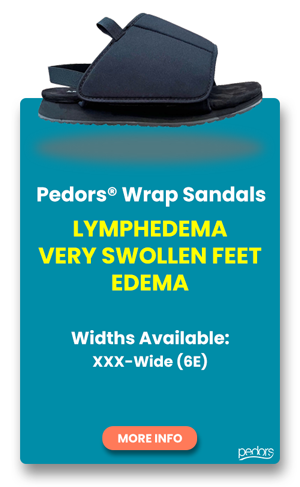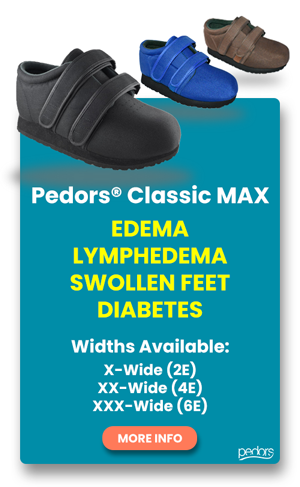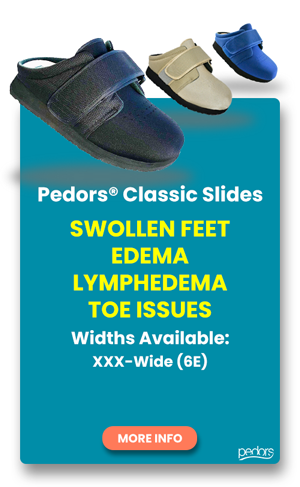Lymphedema / Edema / Swollen Feet
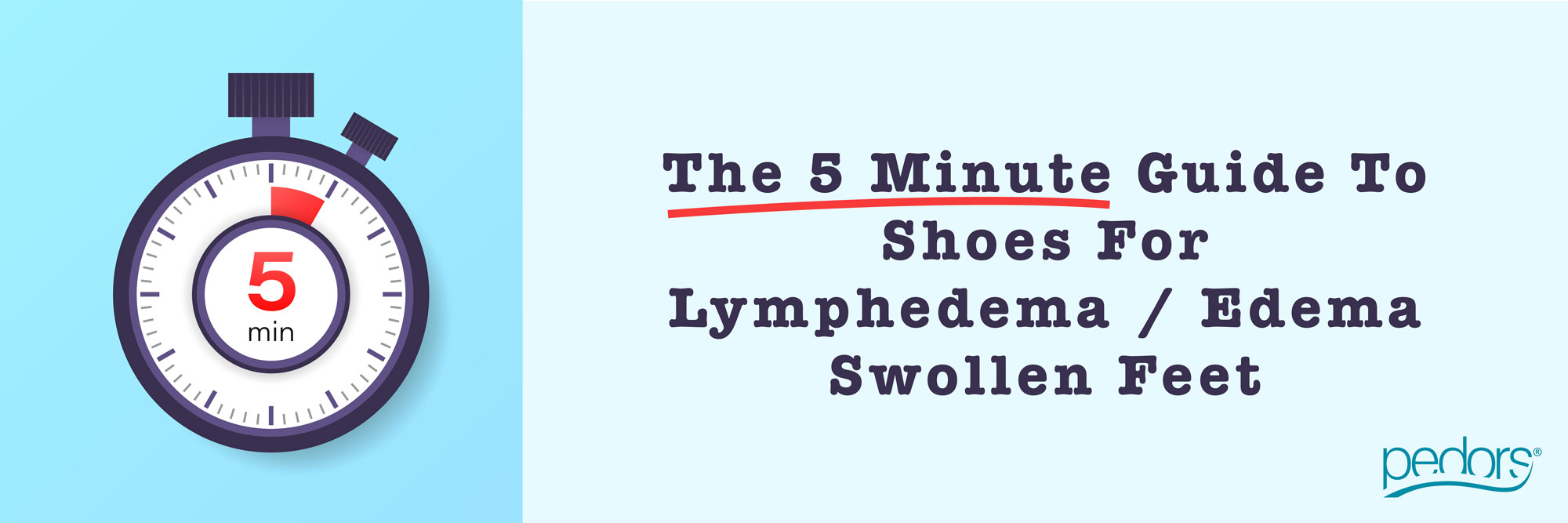
A Five Minute Guide To Shoes For Edema, Lymphedema & Swollen Feet
If you have swollen feet due to Edema or Lymphedema or any other reason, finding shoes that fit, or even shoes that you can get on, can be a source of frustration.
In this quick guide we will define and talk about the differences between Edema and Lymphedema and then discuss what to look for in shoes for those conditions.
Edema Vs Lymphedema
Edema is a term used to describe the swelling of a body part due to fluid accumulation in the body tissue which occurs when tiny blood vessels in your body (capillaries) leak fluid that builds up in the surrounding tissues. Although Edema can affect any part of the body is is most likely to be in the arms, hands, legs, ankles and feet and this is known as Peripheral Edema because it is evident on the periphery (the ends) of your body.
Lymphedema also refers to swelling in one arm or leg (or both at the same time) but the causes for this swelling are different from general Edema / Peripheral Edema. Lymphedema is most commonly caused when lymph vessels are damaged or lymph nodes are removed (as part of cancer treatment) which results in a blockage in the lymphatic system that prevents lymph fluid from draining properly which in turn leads to swelling.
What Causes Edema?
Mild Causes
Sitting Too Long
Too Much Salty Food
Pregnancy
Premenstrual signs / symptoms
Medication Causes
Steroids
Estrogens
High Blood Pressure Medications
Anti-Inflamatory drugs (non-steroidal) Thiazolidinediones (a type of diabetes medication
Disease Causes
Cirrhosis
Kidney Disease / Kidney Damage
Congestive Heart Failure
Weak or Damaged Veins
Long-Term Protein Deficiency
Symptoms
Swelling or puffiness of the tissue directly under your skin, especially in your legs or arms
Stretched or shiny skin
Skin that retains a dimple (pits), after being pressed for several seconds
Increased abdominal size
What Causes Lymphedema?
Primary Lymphedema develops when lymphatic vessels are missing or impaired. More common in younger women, Primary Lymphedema can start near birth, around puberty or later in life.
For both upper and lower extremities Primary Lymphedema is estimated to affect 1 million individuals and Secondary Lymphedema about 2 million individuals in the USA.
Secondary Lymphedema is most commonly caused when lymph vessels are damaged or lymph nodes are removed and there can be a variety of causes including malignancy in breast cancer, where the lymphatic channels are compressed or metastasis can occur in the lymph nodes. Trauma and surgery where the lymph nodes are removed, radiography and chronic infection which can result in fibrosis and eventual lymphatic obstruction.
Symptoms
Swelling of part or all of your arm or leg, including fingers or toes
Hardening and thickening of the skin (fibrosis)
A feeling of heaviness or tightness
Restricted range of motion
Aching or discomfort
Recurring infections
What are the best types of shoes for Lymphedema / Edema / Swollen Feet?
When choosing footwear for swollen feet the shoes need to be deep and wide with the option to add supportive inserts. As the foot swells over the course of the day a velcro or hook and loop closure makes it easier to adjust the fit of the shoe during the day. Shoes that can stretch to accommodate change in volume of the feet during the day is a must have feature.
You may have seen elsewhere that we suggest looking for footwear that keeps to your GOALS.
The TOP 5 Things To Look For When Shopping For Shoes For Swollen Feet
1. First of all the shoe has to have enough volume or girth to accommodate the swelling on the dorsum of the foot (the top of your foot).
2. Second, the shoe needs to be able to open up so that the foot can be easily placed on the footbed. One closure is good, for really swollen feet, two closures is better.
3. The shoe closure needs to be adjustable to accommodate any change in the volume of the foot over the course of the day, as generally, feet swell more as the day progresses.
4. The shoe should be lightweight. A heavy shoe is less likely to be worn which may lead to spells of wearing nothing. An unprotected foot is more likely to be traumatized.
5. The upper material should be soft and not restrictive. Ideally the material might offer some compression to help reduce swelling in the foot, or a stretch component.
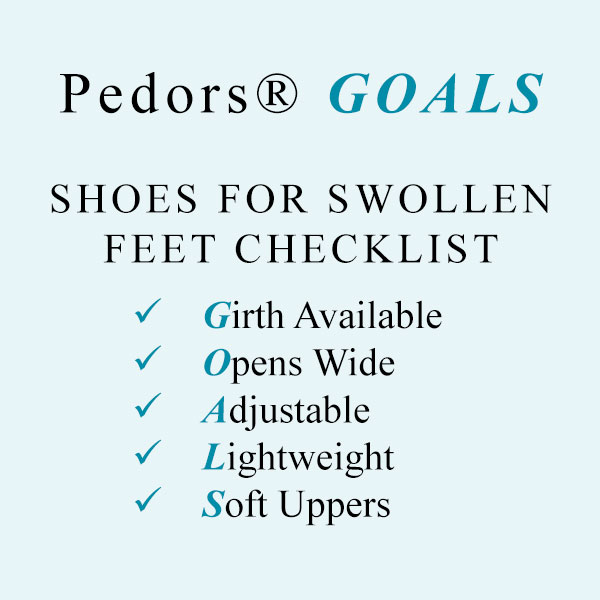
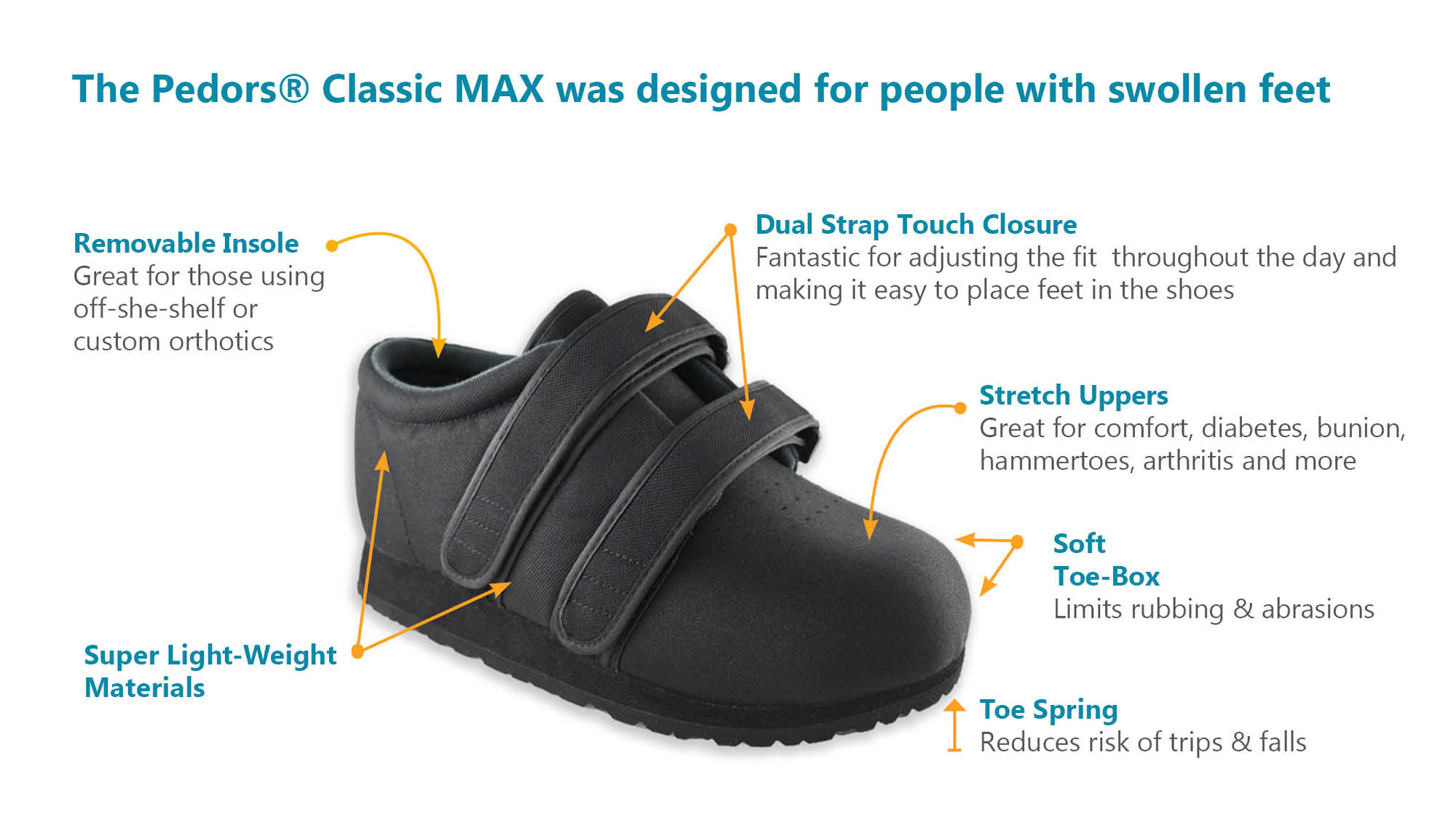
The Pedors MAX 6E collection was designed specifically for people living with the challenge of finding footwear to accommodate lymphedema. The Classic MAX is a shoe for everyday use in and around the house like going to the store, out to dinner or church on Sunday. The MAX Slide is used around the house as a big accommodative slipper that is easy to slide into at night for a trip to the bathroom or kicked off when putting your feet up on the couch. The MAX Wrap Sandal is designed primarily for people with extremely swollen severe lymphedema, chronic venous insufficiency and for people who may have bandaged feet, wear compression garments or have their feet wrapped to help reduce swelling. The primary intent is to get some plantar surface protection for the foot when no other footwear can accommodate the foot. It is a solution for people who find they are walking around in socks because they can't find a footwear solution.
How do I work out what width shoes do I need?
Much of what will work for you will depend on how swollen your feet are. To determine your foot width (that helps to determine what shoes are suitable for you) please refer to our handy sizing guide. It takes just a few minutes to get your measurements and work out what is the best size and width for you.

